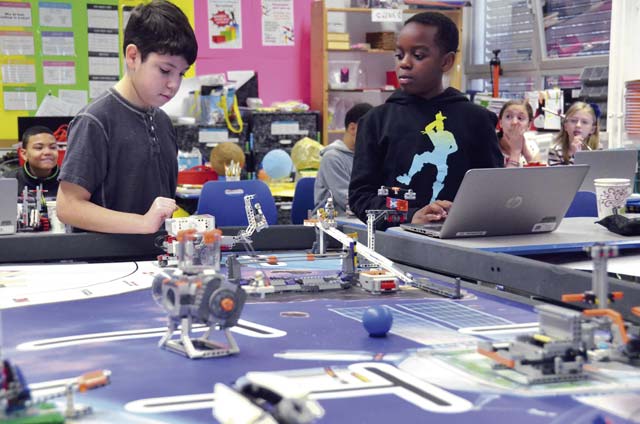
Fourth and fifth graders from Smith Elementary School demonstrated their creativity and technical know-how during the First Lego League competition, March 18.
The annual competition encourages students worldwide to design and construct robots using standardized construction kits and program them to perform complex tasks within a 2 1/2 minute time frame during the event. Six Smith Elementary School teams competed against 46 fourth- and fifth-grade teams at 14 Department of Defense Education Activity Europe schools. The event was broadcasted live to each DODEA Europe school.
Steven Swiger, fifth-grade teacher at Smith Elementary School, used the foundation of engineering to explain robotics concepts to the students.
“During the competition, students serve as structural, design and coding engineers,” he explained. “These skills transfer into life quite easily. With the continued drive toward full automation, our society will need adults with skills the students use daily in this program.”
Two-person teams worked on their bots — meticulously building, programming, testing and problem-solving each machine — until the FLL competition took place six months later. Identical FLL table top playing fields were constructed at each school with teachers and volunteers serving as on-site coaches to score each attempt. During the competition, teams received points for bots correctly performing tasks within the allotted time period.
This competition goes beyond teaching engineering and robotics skills, Swiger said. Students learn teamwork, problem-solving, real-world math and science concepts and risk evaluation.
For “Team Simulation,” the months leading to the competition was as fun as it was challenging for the fifth-grade pair.
“We only get 2 1/2 minutes for our bot to perform its tasks,” said Haley H., a newcomer to SES and the FLL project. “In my opinion, it’s difficult to program because you have to know how far to go to make turns and how fast the bot needs to travel so you can go through the course quickly.”
Her teammate, Yazmine B., said assembling the bot was more difficult.
“The hardest part for me was building the worm drive. At first, we built it wrong because the disc was on the bottom instead of the top and it wouldn’t rotate. It was also very difficult to attach it to the bot,” she said. “It was a lot of fun learning how to build and program it though.”
Although he had never programmed before, 11-year-old Jahmar D. and his teammate Krystine R. were up for the challenge.
“Inputting the programs were the hardest part of the challenge, because just seeing it, you don’t know what you’re going to have to do and how you’re going to do it,” said the fifth grader on the “JK Destroyers” team.
“You have to write a program for each thing you want it to do,” said fourth-grader Krystine. “We programmed our bot to do three things. It was tough at first, but it became easier as we did this more.”
Amia V. from “Team Life Changers” said FLL was cool because “it was one of the only opportunities I got to work with programming a robot,” said the 10-year-old, fourth grader. “I really think the hardest part for me was building the arm, because it was very complicated to figure out how to make it go up and down. Basically, one of the teams had an arm that was really cool, so we asked them, ‘how did you do that?’ We were able to use their idea and improve on it for our bot.”
Overall, Amia liked the program and wants to continue in the FLL competition next year when she moves to another school.
“I think this program is really cool, because at my old school, there weren’t any after school clubs like there are here,” she said.
Amia’s parents, Jacqueline and David, were impressed with the ingenuity and skills their daughter and her classmates demonstrated during the event.
“It was very interesting. Amia tells us a lot about what they are doing, but we didn’t really understand what is going on until now,” Jacqueline said. “It was nice to see what they’ve been doing for the past six months. I’m excited for them, and I think they did well for their first competition. We leave at the end of the school year, so we are hoping she can continue with FLL wherever we move next.”
This is Swiger’s fourth year coaching future engineers for this competition, and he understands how much effort students put into their bots to participate.
“This event is incredibly challenging. Of course, they all think it will be easy when they first look at the table. But, after a few attempts, they realize how meticulous they need every movement to be,” he said.
Encouraging the next generation of engineers and scientists, Swiger said he feels honored to help inspire them in math and science.
“I live vicariously through their eyes. I only wish I could have had such amazing technology to work with when I was a kid,” he concluded. “So instead of standing back and pondering my past, I choose to help the new generation forge their own futures.”


